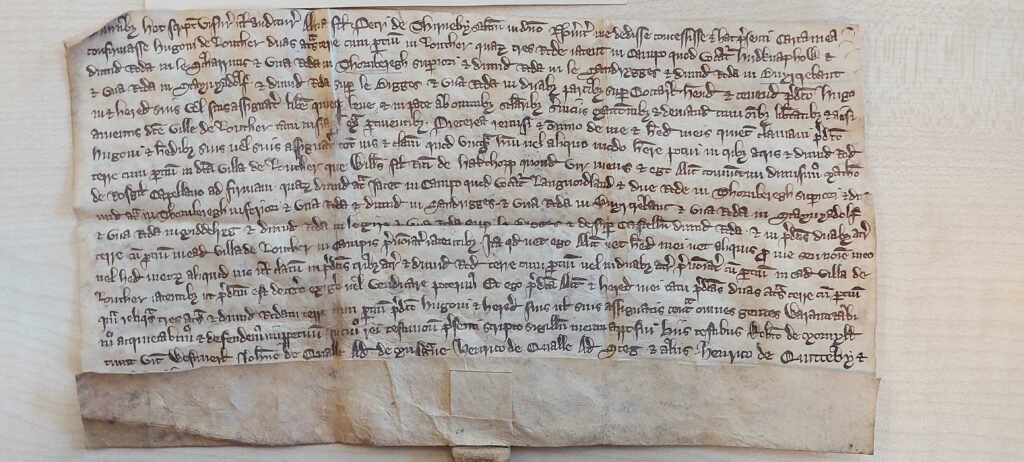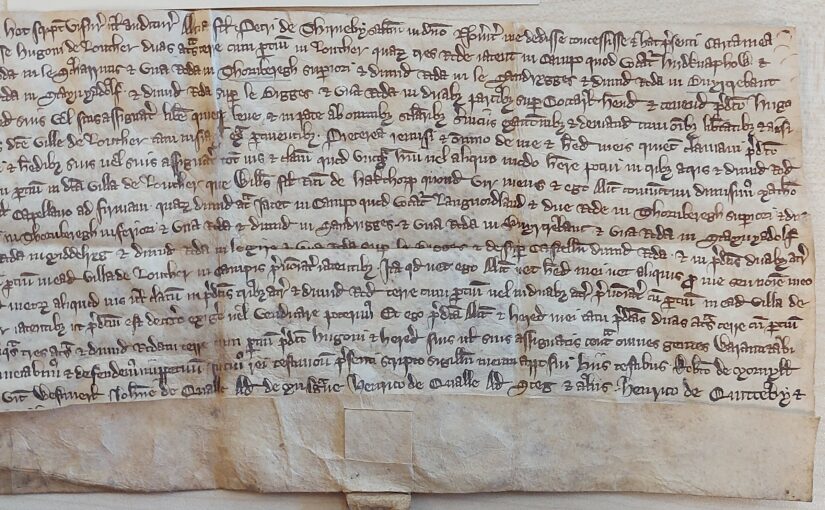In the fifth of our Dig Diaries Sophie Ambler discusses the work she is doing investigating the Lowther archives and seeing how the written record helps with the archaeology.
In the third Dig Diary for the Lowther Castle and Village project, I introduced the (patchy) written evidence for the Norman conquest and colonisation of Cumbria – potentially when our site was established. Here, I’ll introduce some of the earliest written evidence for our site, dating from the thirteenth century.
Our evidence comes from the archive of the Lowther family, held in the Cumbria Archive Centre in Carlisle. This archive is largely uncatalogued, held in boxes arranged by manor (administrative units within the larger estate). There are six boxes pertaining to the Lowther manor, containing several centuries’ worth of documents. Sifting through them is a long but exciting task.
Subscribe to our quarterly newsletter
Readers might have spotted that ‘Lowther’ – the name of the family that has held the estate for centuries, as well as the name of our manor and village – is not a Norman name. In fact, ‘Lowther’ is the name of the river running below our site. The name’s origins are uncertain but might derive from the Old Norse for ‘foaming water’. The Lowther manor and its principal settlement (our village site) took their names from the river, and the family took its name from the manor and/or village. This practice was common in the thirteenth century. People didn’t generally have surnames (sometimes occupational names, e.g. John le Carpenter), and were often referred to either by their parentage (e.g. John fitz/son of Agnes) or their home (e.g. John of Hackthorpe).
Our central character is Hugh fitz Geoffrey of Lowther – or, as he was more commonly known, simply Hugh of Lowther. In the 1280s, Hugh was one of several men known as so-and-so ‘of Lowther’. He was one of the manor’s four leading landholders, who held their lands in Lowther from a tenant-in-chief of the king. But it was Hugh who would make his fortune, so that in the fourteenth century his descendant could be described as ‘Hugh of Lowther, lord of Lowther’.
Hugh made his money as a sergeant (an early form of barrister) in the central courts of King Edward I. His career has been traced by Professor Paul Brand, who has researched the emergence of a new class of professional lawyers in the late thirteenth century. Hugh, together with his wife Ivette, used the money earned practising law to build a property portfolio in Lowther manor and village. By c.1292, Hugh had become a knight. (He also went on to take part in Edward I’s conquest of Scotland, but that’s another story!)

It’s the documents drawn up for Hugh and others of the manorial community to record grants, sales and exchanges of land that provide our evidence for the site. These give the names of the women and men granting or receiving property, the names of the men who stood witness to a grant, and the parcels of property conveyed – sometimes described with highly localised placenames, and landmarks.
Using this material as evidence for the landscape and use of our site, together with archaeological findings, will be a long and fiddly process, but here’s a taster.
This is a charter, dating probably to the 1280s, recording two points. First, a grant of two acres of land in Lowther by Alice daughter of Peter of Thrimby to Hugh of Lowther (comprising various small parcels, each described by local names). Second, Alice’s quitclaim to Hugh of rights in three acres and half a rood of land (there were four roods in an acre) in the vill of Lowther, which she and her late husband, William fitz Richard of Hackthorpe, had demised to Matthew of Rosgill, chaplain. Again this land is broken into parcels, each described. One of these is half a rood (an eighth of an acre) ‘above the castle’. You can see ‘castellum’ along the lateral fold of the charter.
Could this refer to the ringwork castle we’re investigating? This would be a good bet, as there is no evidence of another castle on the site at this date. In which case, this reference gives us a glimpse of how people in the village were using the castle as a marker in their landscape.
Subscribe to our quarterly newsletter
Follow the project on Twitter via the hashtag #LowtherMedievalCastle
Charter archive reference: Carlisle Archive Centre, Carlisle, DLONS/L/5/1/26 LO35, Copyright Lowther Estates.
